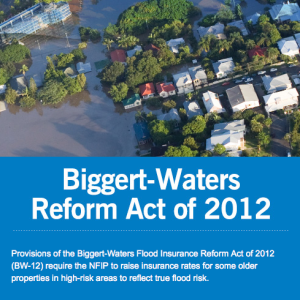Flood Insurance Update – they are working on a bill to lower the premium increases

If passed there it will substantially change the 2012 Biggert-Waters Flood Insurance Reform Act which was enacted to help move hundreds of thousands of homeowners away from subsidized rates and make the The National Flood Insurance Program more financially viable.
The Florida real estate industry, as well as buyers and sellers of Florida property, are excited about a plan that will scale back the changes to the National Flood Insurance Program which have sent premiums skyrocketing.
Huge premium increases have had a dramatic affect on Florida, North Carolina, and Georgia real estate, making the cost of insuring homes in flood prone areas unaffordable. These increases have slowed home sales and have threatened the local real estate recovery.
Recently, the U.S. House of Representatives passed a bill that allows sellers of homes in flood prone areas to pass along their subsidized flood insurance rates to the new buyer. The bill also lowers the cap on how high flood insurance premiums can go up each year. The bill enjoyed widespread bipartisan support and easily passed the house with a vote of 306-91.
The legislation now moves to the U.S. Senate. If passed there it will substantially change the 2012 Biggert-Waters Flood Insurance Reform Act which was enacted to help move hundreds of thousands of homeowners away from subsidized rates and make the The National Flood Insurance Program more financially viable.
The National Flood Insurance Program is currently $24 billion in the red and 40 percent of the homes covered by the program are in the state of Florida.
Homeowners See Much Higher Premiums
Florida, North Carolina, and Georgia homeowners, as well as other coastal communities have been hit hard by skyrocketing premiums. In some cases, annual premiums have gone up over 1,000 percent. One unlucky homeowner saw their premium go from $1,400 a year to over $6,000.
The higher premiums have been putting a damper on home sales and have made it next to impossible for some homeowners to sell their property. As potential buyers investigated the cost of flood insurance many deals fell through due to the high cost of insuring the home. Local real estate agents applauded the new legislation and believe it will bring some stability to the marketplace.
Details of the Bill
The new bill would repeal a provision of the Biggert-Waters Flood Insurance Reform Act that was responsible for imposing sharp premium increases on people who purchased a home in a flood prone location.
A big item in the new law is a reinstatement of grandfathering of properties that were built to code at the time that they were constructed. These homeowners will be protected from the skyrocketing rates that are coming about due to re-mapping.
In addition it will preserve the below-market rates for current homeowners who fall into federal flood maps. Homeowners who purchased houses after the Biggert-Waters Flood Insurance Reform Act was put in place will see their premiums capped at an average of 15 percent a year and the maximum increase would be capped at 18 percent. The annual cap with Biggert-Waters was 20 percent.
If the house is a second home and in flood zone or a house that has repeatedly flooded, owners would see their premiums rise 25 percent a year until it was consistent with the actual cost of insuring the property.
Under the changes, the Federal Emergency Management Agency (FEMA) would be able to increase premiums every year but the increases could not be as high as mandated under the Biggert-Waters Flood Insurance Reform Act. The subsidies would be offset by a surcharge on all of the 5.6 million policyholders.
Another key provision of the bill is ensuring the accuracy of federal flood maps as well as giving towns and cities the chance to review the maps as well as the methodology that was used to determine the flood zones. The legislation gives municipalities 30 days to review and then comment on the flood maps before they become official.
